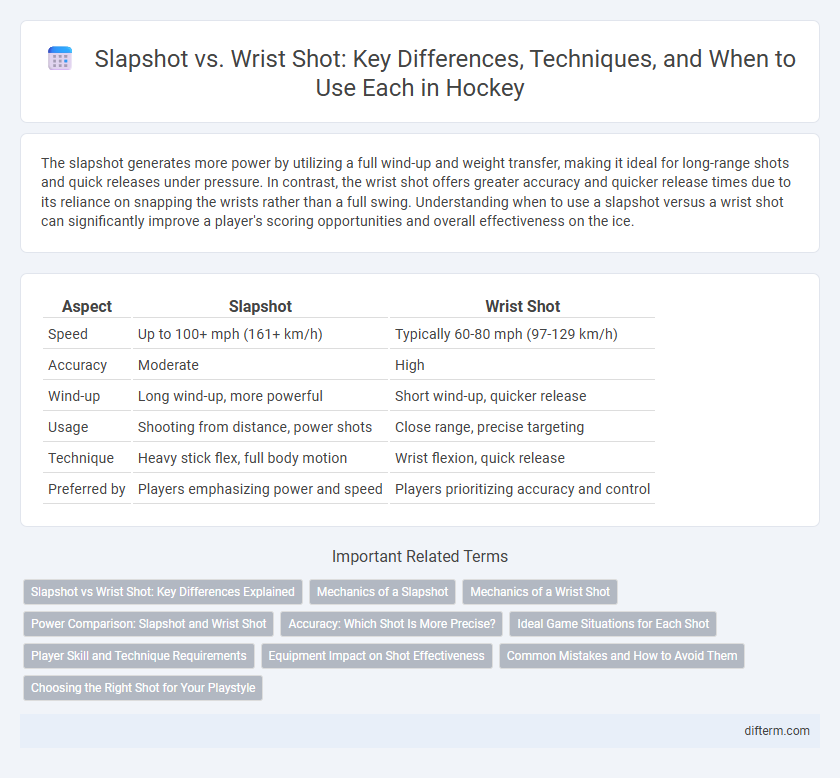The slapshot generates more power by utilizing a full wind-up and weight transfer, making it ideal for long-range shots and quick releases under pressure. In contrast, the wrist shot offers greater accuracy and quicker release times due to its reliance on snapping the wrists rather than a full swing. Understanding when to use a slapshot versus a wrist shot can significantly improve a player's scoring opportunities and overall effectiveness on the ice.
Table of Comparison
| Aspect | Slapshot | Wrist Shot |
|---|---|---|
| Speed | Up to 100+ mph (161+ km/h) | Typically 60-80 mph (97-129 km/h) |
| Accuracy | Moderate | High |
| Wind-up | Long wind-up, more powerful | Short wind-up, quicker release |
| Usage | Shooting from distance, power shots | Close range, precise targeting |
| Technique | Heavy stick flex, full body motion | Wrist flexion, quick release |
| Preferred by | Players emphasizing power and speed | Players prioritizing accuracy and control |
Slapshot vs Wrist Shot: Key Differences Explained
A slapshot generates higher puck velocity through a powerful wind-up and full stick flex, making it ideal for long-range shooting in hockey. Wrist shots offer greater accuracy and quicker release by relying on wrist movement and less stick flex, perfect for close-range scoring opportunities. Understanding slapshot vs wrist shot differences enhances shooting technique and improves overall performance on the ice.
Mechanics of a Slapshot
A slapshot generates maximum power through a powerful winding motion that transfers energy from the legs and hips to the stick, utilizing a significant flex in the stick as it strikes the ice just before the puck. The mechanics involve a sweeping, forceful follow-through to increase puck speed, often exceeding 100 miles per hour. Precise timing and body coordination are crucial to effectively harness the kinetic chain from the lower body to the upper body for an explosive shot.
Mechanics of a Wrist Shot
The mechanics of a wrist shot in hockey primarily involve a smooth, controlled release powered by the flex of the stick and precise wrist motion. Unlike a slapshot that relies on a full wind-up and body rotation to generate power, a wrist shot emphasizes quick acceleration and accuracy through the transfer of energy from the hands and forearms to the puck. Key elements include a firm grip, a gradual blade roll, and a follow-through that directs the puck with accuracy and speed.
Power Comparison: Slapshot and Wrist Shot
Slapshots generate significantly higher power than wrist shots, often reaching speeds exceeding 100 mph due to the full-body force and stick flex utilized during the shot. Wrist shots prioritize accuracy and quick release but typically achieve puck speeds around 70-90 mph. The biomechanical differences result in slapshots delivering greater force, making them the preferred choice for distance shots and power plays.
Accuracy: Which Shot Is More Precise?
Wrist shots typically offer greater accuracy than slapshots due to the controlled release and precise puck placement they allow. Slapshots generate higher puck velocity but sacrifice precision because of the wind-up and follow-through mechanics. Therefore, players aiming for precise targeting, especially in tight game situations, often prefer wrist shots over slapshots.
Ideal Game Situations for Each Shot
Slapshots excel in situations requiring maximum power and distance, such as clearing the puck from the defensive zone or taking long-range shots on goal, with speeds often exceeding 100 mph. Wrist shots offer superior accuracy and quick release, making them ideal for close-range scoring opportunities and precise passes during fast breaks or tight offensive plays. Choosing between a slapshot and wrist shot depends on the player's position, game tempo, and the spatial dynamics around the net.
Player Skill and Technique Requirements
Slapshots demand advanced player skill and precise timing to generate maximum power and speed, relying heavily on proper weight transfer and stick flex control. Wrist shots require superior hand-eye coordination and fine motor skills to execute quick, accurate releases with minimal windup. Mastery of both techniques enhances a player's versatility and scoring potential in dynamic game situations.
Equipment Impact on Shot Effectiveness
The effectiveness of slapshots versus wrist shots is heavily influenced by the design and material of the hockey stick and puck. Slapshots benefit from stiffer, heavier sticks that maximize energy transfer, while wrist shots require lighter, more flexible shafts for better control and accuracy. The puck's weight and surface texture also affect shot speed and precision, emphasizing the crucial role of equipment in shot performance.
Common Mistakes and How to Avoid Them
Common mistakes in slapshot execution include improper weight transfer, resulting in reduced power, and poor follow-through, which affects accuracy. For wrist shots, failing to lock the wrist properly and not generating enough puck rotation often lead to weak shots. To avoid these errors, players should focus on balanced stance, controlled weight shift, and proper wrist snap technique to enhance both power and precision.
Choosing the Right Shot for Your Playstyle
Selecting between a slapshot and wrist shot depends on your playstyle and game situation. A slapshot delivers powerful, long-range shots with maximum speed, ideal for aggressive players seeking quick scoring chances, while a wrist shot offers greater accuracy and quicker release, perfect for precise targeting and close-quarters gameplay. Understanding your strengths and positioning on the ice ensures you utilize the optimal shot to maximize scoring potential and control during play.
Slapshot vs Wrist Shot Infographic

 difterm.com
difterm.com